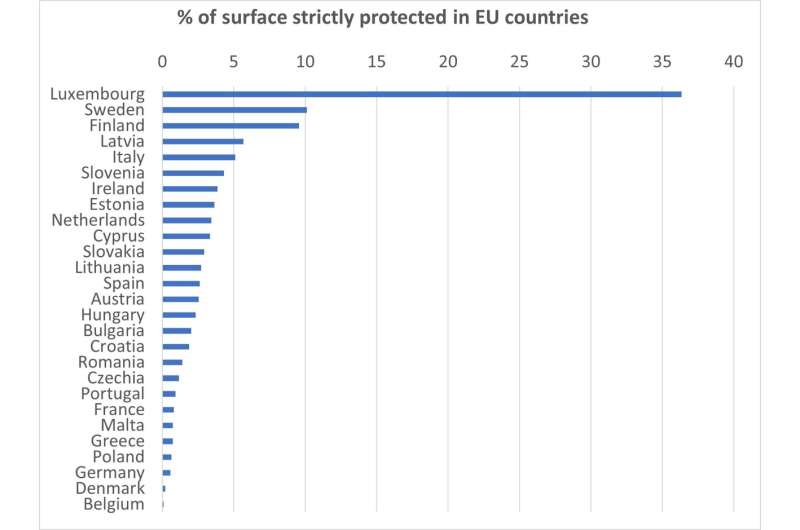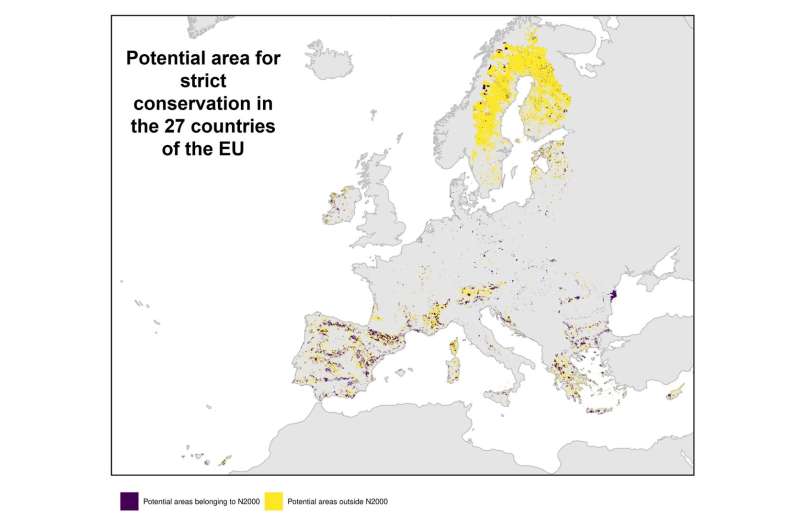This article has been reviewed according to Science X's editorial process and policies. Editors have highlighted the following attributes while ensuring the content's credibility:
fact-checked
peer-reviewed publication
trusted source
proofread
Protection of biodiversity and ecosystems: Study finds Europe is still far from meeting its targets

The goal of fully protecting 10% of the EU's land area is ambitious for European countries that have been profoundly shaped by millennia of human transformation. A recently published study in Biodiversity and Conservation, coordinated by the University of Bologna, has carried out the first analysis at European level on the strictly protected areas (classified by the IUCN as integral reserves, wilderness areas and national parks) across the EU, studying how extensive integral protection is across biogeographical regions, countries and elevation gradients.
"We have discovered that the current strictly protected area in the EU 27 is extremely unbalanced between biogeographical regions, countries and altitude bands (for example, we find very few strictly protected areas in the plains and at low elevations) and, with very rare exceptions (only Luxembourg and Sweden are above the threshold identified by the EU, with Finland very close), most countries are much below the 10% strict protection goal.
"It will therefore be necessary to work to get closer to the conservation objectives set by the EU 2030 Strategy for biodiversity through rigorous international cooperation between countries and the commitment of individual states to identify national areas to be allocated for protection," explains Prof. Roberto Cazzolla Gatti, conservation biologist at the Department of Biological, Geological and Environmental Sciences (BiGeA) of the University of Bologna and first author of the study.
The conservation of global biodiversity is one of the most urgent objectives for the coming decades. Habitat destruction, degradation and fragmentation of 70% of the earth's surface are the main causes of biodiversity loss and are triggering the sixth mass extinction. In Europe, there is not a single contiguous area of more than ten thousand square kilometers left free of human impacts. However, there are still areas with high wildness and rather intact ecosystems present, mainly, within protected areas.
In May 2020, the "European Biodiversity Strategy for 2030" was signed: an ambitious plan to protect biodiversity and reverse the degradation of ecosystems. With this strategy, the European Union aims to expand the network of protected areas up to 30% of its territory, applying an integral protection of 10% of the land and sea surface for all EU countries. The achievement of the objective of rigorously protecting these areas represents a fundamental element for achieving the long-term conservation of ecosystem processes and the maintenance of high levels of persistence of biodiversity.
"According to the European Commission, strictly protected areas are areas that are completely and legally preserved, designated for conservation or restoration the integrity of natural areas rich in biodiversity and natural environmental processes. This definition gives a clear idea of which should be considered strictly protected in the EU context. Within these areas all industrial, extractive and destructive uses and activities that disturb species and ecosystems such as mining, deforestation, aquaculture and construction, they are usually not allowed.

"Rigorously protected areas must be seen as places where ecological and evolutionary processes are left substantially undisturbed to ensure the persistence of biodiversity. Therefore, it is necessary that in these areas human activities are limited and well controlled, allowing the natural development of natural processes.
"Management actions may be permitted to support or enhance natural processes, as well as the restoration or conservation of habitats and species for which the area has been designated to be protected," said Prof. Alessandro Chiarucci, director of the BiGeA Department of the University of Bologna and coordinator of this research project.
The study also notes that the current scenario could very probably be even worse than the one represented here since the management of some protected areas, such as the peripheral areas of national parks, does not always correspond to integral protection.
In fact, some national parks, although classified as strictly protected, allow a wide range of anthropogenic activities in some of their areas (for example forestry, agriculture, hunting or grazing of domestic animals), hindering the conservation of some ecosystem processes. The authors of the study highlight how important it is to preserve large spaces without (or with very limited) human disturbance to ensure real ecological connectivity.
"Therefore, it would be necessary to identify potential areas to expand integral protection with low economic and social costs, including, for example, areas with a high biodiversity value, but low population and land use. However, considering that in Europe most of the territory has been profoundly modified by man, strictly protected areas should also include territories that currently have a lower protection status, such as those in the Natura 2000 network, and which can recover their biodiversity value through restoration and rewilding," concludes Prof. Cazzolla Gatti.
To achieve the objectives set by the EU 2030 Strategy for Biodiversity, it will first of all be necessary to identify a sufficient area to be fully protected for 10% of each member country. Until now, a biogeographic and ecological analysis of the coverage of strictly protected areas in the EU has been lacking and this has limited the definition of large-scale conservation policies. This study represents a further contribution towards greater conservation of European biodiversity.
More information: Roberto Cazzolla Gatti et al, Analysing the distribution of strictly protected areas toward the EU2030 target, Biodiversity and Conservation (2023). DOI: 10.1007/s10531-023-02644-5
Journal information: Biodiversity and Conservation
Provided by University of Bologna


















